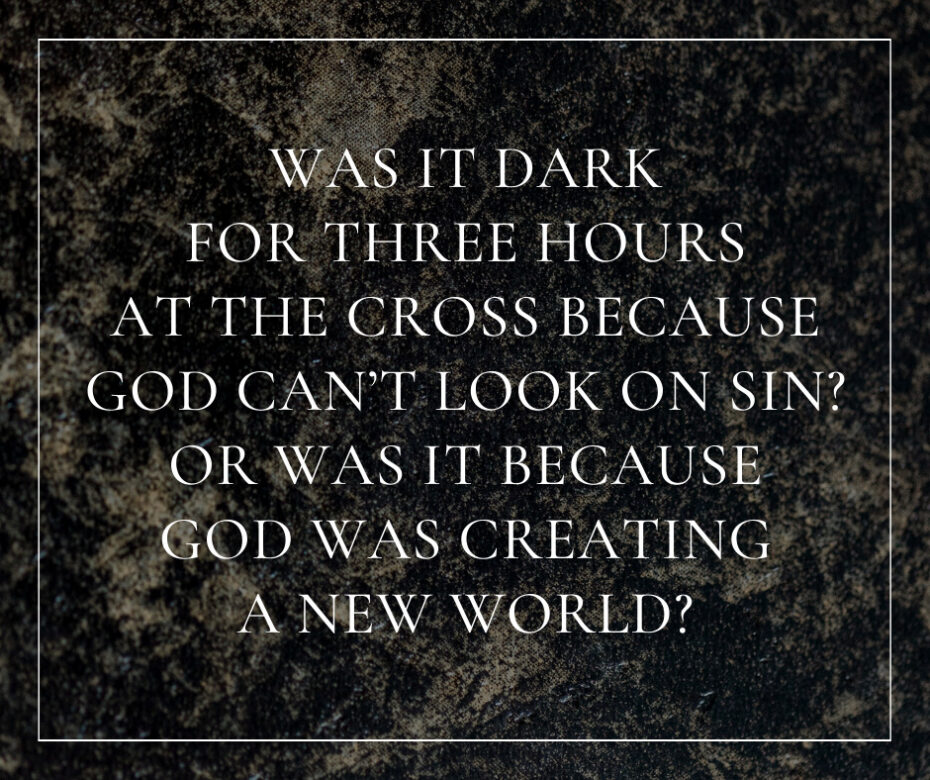In part 1, I argued that the centurion at the foot of the cross wisely considered the darkness at the time of Christ’s death and came to some surprisingly good conclusions about who Jesus is. We should ask the significance of that darkness as well.
First of all, however, I would like to consider some popular opinions of what the darkness signifies. Even though they reflect certain Biblical truths, I don’t think they give the reason why the light of the sun disappeared for three hours in the middle of the day on the day the King of Israel died.
I am fairly confident that you have been told the same thing I have been told about that strange darkness. It pictures that fact that God the Father turned His back on His Son. Jesus took the sins of the world upon Himself and God cannot look at sin. He could not gaze at His Son. As He turned away, the sky became dark. I have heard many sermons stating that is the reason for what happened.
A major reason for this view is that Jesus cried out about God forsaking Him on the cross (Mark 15:34). He felt that His Father has abandoned Him at that moment, and Christ had never experienced separation from His Father. We are simply left with the knowledge that we cannot understand what the Lord was going through. Darkness is the apt picture of such a profound spiritual experience of the Lord.
There is, of course, truth in this view. There is no sin in God (1 John 1:5). He cannot abide in sin. Perhaps we could conclude that this is how He would respond even if His very Son became sin for us (2 Cor 5:21). It seems reasonable.
However, God does indeed look at sin. He sees sin in His people all the time. There is a difference between being able to see sin and being sinful. God can do the first. He cannot be the second.
It is likely that this view would not have gained any traction were it not for the cry of the Lord about the Father forsaking Him. Nothing else in the context suggests it. It is interesting that Luke, in his account of the crucifixion, did not record this cry of the Lord. Instead, Christ spoke of His closeness with the Father (Luke 23:43, 46). I will argue in the next blog that the cry of the Lord was not a cry of abandonment, but a cry of victory. Seen in that light, the idea that the Father turned His back on the Son on the cross and that this caused the sky to turn dark is not an attractive option.
Another common view is that the darkness takes us back to Genesis 1. Just as the world was shrouded in darkness before God created our present world, so in Christ, God is creating a new world. The OT prophets spoke of a time of darkness before the coming of the Lord (Joel 2:31). The last days are upon us. Christ is dying, but the kingdom is dawning. It is the darkness before the light of a new creation.
There is, of course, truth to this teaching as well. There will be darkness before the coming of the Lord to establish the kingdom of God. Peter would preach this truth about 50 days later (Acts 2:20). Decades later, John would say the same thing (Rev 6:12-13). The problem with this view is that the coming of the kingdom did not occur immediately after the death of Christ on the cross. The darkness predicted by Joel and other prophets still look forward to a future day. The kingdom of God, which will come immediately after the darkness, still has not arrived. The new creation hasn’t come. I would also argue that there is nothing in the context of Mark 15 that speaks of a new creation.
While there are certain Biblical truths connected to these two popular understandings of the darkness at the cross of the Lord, I think there is a better way to interpret that darkness. It had a meaning for the nation of Israel and a meaning for believers. Both meanings centered around a particular theme. It is the theme of judgment.


